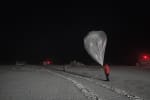The IceCube Neutrino Observatory, a cubic-kilometer-sized telescope at the South Pole, has been issuing real-time alerts to the public within minutes of the detection of astrophysical, ghostlike particles called neutrinos. However, the sources of the astrophysical neutrinos detected by IceCube remain largely unknown. One class of objects that are probable sources of astrophysical neutrinos are […]
News
Week 18 at the Pole
IceCube winterover Hrvoje, who took the photo above, was excited to see the sun coming up again at the South Pole, except…that’s the moon and not the sun! (Of course, he knew that all along.) But what an illusion, this image of the moon—it could fool anyone. And the moon has played such games before. […]
IceCube measurement of atmospheric neutrino mixing using improved DeepCore calibration, data processing
When cosmic rays strike Earth’s atmosphere, they produce air showers containing atmospheric muons and neutrinos—tiny, nearly massless particles—that rain down on Earth. The atmospheric neutrinos are then detected by the IceCube Neutrino Observatory at the South Pole. These atmospheric neutrinos come in three different flavors—electron, muon, and tau–and can become a different flavor or “oscillate” […]
Week 17 at the Pole
First up—last week featured a weather balloon launch. That’s IceCube winterover Marc lending his assistance. He also spent some time helping out with preparations for a repair to one of the power generators. A trip to the South Pole power plant is always an interesting visit. Last week’s activities also included some detector troubleshooting, a […]
Week 16 at the Pole
Ahh, auroras! We knew they’d come…and now the first of the season have been captured by IceCube’s winterovers. It’s still not completely dark outside, but the skies are still impressive. Above are the first faint auroras seen over the South Pole station, and below seen over the Dark Sector, with the IceCube Lab (ICL) visible […]
Week 15 at the Pole
Last week at the Pole, they had their Easter dinner—since the kitchen staff doesn’t normally work on Sundays, it was delayed, but only by a day. There was an assortment of colored and decorated eggs as part of the festivities, too (maybe next week they’ll have egg salad?). IceCube’s winterovers were busy with quite an […]
ICECAT-1, IceCube’s first event catalog of neutrino “track” alerts
Since 2016, the IceCube Neutrino Observatory—a detector buried in a cubic kilometer of Antarctic ice—has been issuing real-time alerts sent to the public within minutes of the detection of astrophysical, ghostlike particles called neutrinos. IceCube’s prompt observations are key in the emerging field of multimessenger astronomy where the combined measurements across the electromagnetic spectrum are […]
Week 14 at the Pole
It was a quiet week at the Pole, at least for IceCube’s winterovers, with smooth detector operations—no problems or urgent troubleshooting. But there were still the typical activities, like maintenance work, emergency response training, and a cause for celebration (last week it was Easter). It was also quiet outside, with clear skies to enjoy the […]
Week 13 at the Pole
The sun may be gone, but its light still lingers. At the Pole, sunset doesn’t just “happen”—it takes place slowly through prolonged stages of twilight, after the sun dips below the horizon, in which the light gradually diminishes until darkness reigns. That’s IceCube winterover Marc, above, outside the IceCube Lab as he gets ready to […]
First spectral search of monochromatic neutrino lines from dark matter annihilation and decay in IceCube
Despite making up roughly 85% of all matter in the universe, dark matter (DM) still remains an enigma to astronomers and physicists. One outstanding question is the microscopic nature of DM, and thus far, no experiment has been able to determine what it is made of. To probe the nature of DM, scientists look for […]









